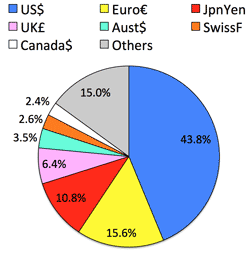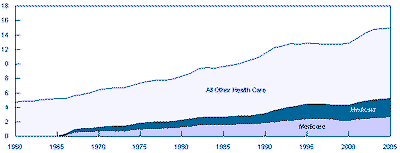>Top 5. Japanese housewives take the Commanding Heights:
- In mid-1980s, Japan was fully expected to own 21C:
- Japanese interest rates are far lower than the rates throughout the rest world, global investors borrow huge amounts of capital from Japanese financial institutions to invest globally.
- What happens when a financial bubble burst, when price level actually drop too low, and when central bankers become powerless to come to the rescue.
- How Japan's big corporations almost alone have benefited big time from this deflationary, low interest rate period.
- Successful megafirms represent half of the stock market.
- The market itself reflects only 10%; the other 90%, the neglected part not reflected in stock market valuations.
- >Top In Japan, the yen exchange rate is a driving force in everyday life.
- The Plaza Accord to allow the dollar to weaken to reduce global trade friction with US. The yen jumped from254 in Jan. 1985 to127 by late 1990.
- The bubble economy: from 1986 to 1989, supercharged Japan purchases Rockefeller Center in NY. The Emperor's Palace was worth more than the real estate value of the entire state of Californio.
- Nikkei stock index nearly hit 39000 yen high mark.
- Nosedive by too little too late policy: By 1987, the short-term interest rate had been dropped to 2.5%. By 1989, it raised to 6%.
- Liquidity trap: Interest rates are so low that bonds and cash are virtually interchangeable. Thus the central bank is unable to expand liquidity by buying bonds.
- >Top Deflationary spiral: during the lost decade, relative prices dropped by 25% compared to US.
- Ever worse, the central bank lost its ability to affect long term interest rates. Long term interest rates had been 7.5% in 1990; which dropped below 1% by 1990. BOJ had no choice but to cut its overnight interest rate to 0%,
- By the late 1990s, Japan's zero interest rate policy also allowed the large banks to start to clean up their disastrous balance sheets.
- >Top Then the banks took those deposits and bought risk free JG debt (JGB) 1.5-2% higher than the interest paid to savers.
- In Japan, an aging, high-saving country, a lot of people traditionally have deepened on savings account returns to supplement their income. Household interest income from saving accounts, ¥39T in 1991, plummeted to a mere ¥3T by 2005.
- >Top 2005-2006: the bottom 50% of Japanese actually saw their incomes drop. The middle 40% experience flat annual income.
- Here's where the housewives come into play. The housewife has assumed the role of financial matriarch; began to find for a greater return on their savings; found more robust returns in foreign bonds and other overseas investments; today 1/5 of all currency traders worldwide, are Japanese private individuals, many of them women.
- Tokyo became the last resort for a Western financial system desperate for liquidity.
- >Top In Japan, there is something unnatural about the market volatility of a liberalized financial system. Bureaucrats are bred to prohibit failure; who don't know how to deal with the entrepreneurial uncertainty and failure that are essential to economic success.
- Japanese-style market economy culturally has no choice but to be a bit less open, less transparent, and more regulated.
- High profile individual risk-taking within an Anglo Saxon style open market is somehow inconsistent with the Japanese psyche.
- The tiny number of large Japanese banks today, having merged and merged again, are hardly interest in investing in unknowns; this si particularly the case after the bank balance sheet debacle of the lost decade.
- While the outside world often perceives a lack of transparency within the Japanese economic and financial system, the Japanese elite ironically seem to know everything about each other.
- Innovation entails risk and potential failure, which are not easily accepted in Japan's tightly controlled system.
- >Top Productivity revolution:
- Several years ago signs of Japanese structural reform excited the world financial community; raised the prospect that this could be the beginning of a productivity revolution.
- The under-consuming economic system, heavily export-dependent, would be highly vulnerable in the event of the bursting of the Asian bubble; Japanese economy is experiencing a downward drift as even the healthy export sector is being seriously squeezed by the strengthening yen.
- Psychological factors stemming from the rapid aging of Japanese society and a growing sense of risk aversion.
- Japan's national public debt load resulted during 1990s era of cheap money.
- Monetary authorities know that today's absurdly low interest rate climate represents a dangerous distortion for the Japanese system; its mountains of hidden debt have placed the economy in a policy straitjacket.
- There wil be limits to the level of debt an economy can carry.
|
5.
日本の主婦が管制高地を占拠:
>Top Commanding heights:
- Speech by V. Lenin describing the parts of an economy that effectively control and dominate the other parts.
- In the economy of 21C, Japanese housewives find themselves perched atop the commanding heights. They unwittingly have become big player in the Japanese and world financial system.
|
- Commanding heights:
- 日本のバブル経済: 1986-89
- デフレスパイラル
- 日銀の低金利政策: 1990までに1%
- 国債
- 高齢化社会による消費減
- 日本の構造的な貧困化:
底辺50%は収入源/中間40%は現状維持
- 主婦層による金融取引参入: 預金金利減による対抗策
- 世界の為替取引の1/5相当
- 日本の市場変動率(Market volatility)への抵抗:
- 消費減
- 輸出志向
- 急速な高齢化社会
- 国債
- 金融当局の矛盾
|


